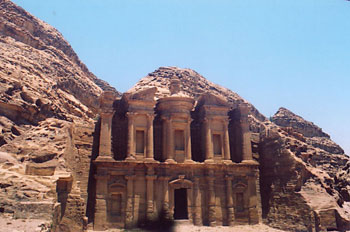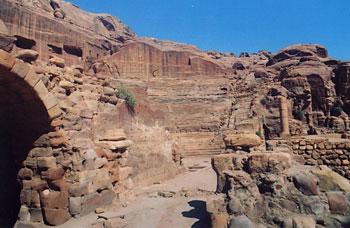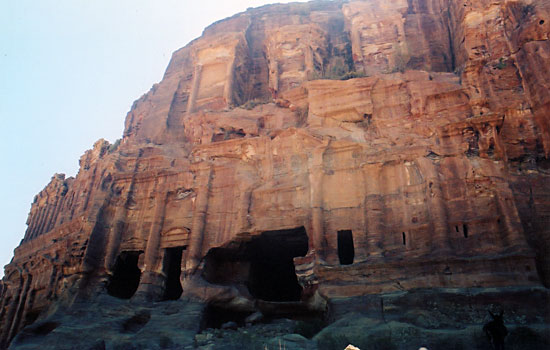Petra on a Two-Day Pass (Overview)
Once flourishing, then forgotten by the world, it inspired pilgrimages and countless myths. One
compelling theory states its provision by God to protect the faithful from the Antichrist during
Armageddon. I speak, of course, of PETRA.
 As evidenced by the keytar and jaunty porkpie hat, Petra rocks pretty hard. According to the official website, the Christian metal-lite band will be calling it quits in December 2005 after 33 years of said rocking. I can sense your pain.
As evidenced by the keytar and jaunty porkpie hat, Petra rocks pretty hard. According to the official website, the Christian metal-lite band will be calling it quits in December 2005 after 33 years of said rocking. I can sense your pain.

|
| Al-Deir, the monastery |

|
| Inside the Roman theatre |
Petra was the capital city of the Nabataean empire, dominant circa 6th century BC. Architects built the temples and theatre based on Roman design well before the Romans captured the city in 106AD. As no literature survived, the Nabataeans' culture remains a mystery today.
Rediscovered in the 19th century by Swiss explorer Johann Burckhardt, popularized through his accounts and featured in Indiana Jones and the Last Crusade, Petra today is a marvel. A stunning rose-red city hidden within rugged desert canyons, the ruins are only one-twentieth excavated. Bedouin families still live in the caves, although the government created a modern settlement outside to preserve the site.
Well worth the pricey entrance fee, Petra was by far my favorite part of Jordan, breathtaking at every turn and populated by lovely people. Named a World Heritage Site in 1985 and a national park in the early 1990s, Petra received both the benefit and the damages of 400,000 visitors yearly until September 11th cut down tourism. Currently, the nearby village of Wadi Musa has been encroaching on the site to support the tourist industry. Two thousand years of erosion have also taken their toll. To sum up, see it as soon as possible—before the locals become jaded, before too much more damage is done.

|
| Corinthian tomb |